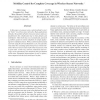Free Online Productivity Tools
i2Speak
i2Symbol
i2OCR
iTex2Img
iWeb2Print
iWeb2Shot
i2Type
iPdf2Split
iPdf2Merge
i2Bopomofo
i2Arabic
i2Style
i2Image
i2PDF
iLatex2Rtf
Sci2ools
87
Voted
ICDCSW
2008
IEEE
2008
IEEE
Mobility Control for Complete Coverage in Wireless Sensor Networks
In this paper, we propose a new control method to cover the “holes” in wireless sensor networks. Many applications often face the problem of holes when some sensor nodes are disabled from the collaboration due to their failures and misbehavior. These holes may occur dynamically, and such a problem cannot be solved completely by simply deploying more redundant sensors. With a synchronization around each hole using the directed Hamilton cycle, one (and only one) snake-like cascading replacement process will be initiated in the local area in order to fill in that vacant area with a spare node. In this way, network connectivity and coverage can be guaranteed. Our analytical and experimental results show substantial improvements of such a replacement compared with the best result known to date.
Distributed And Parallel Computing | ICDCSW 2008 | Sensor Nodes | Snake-like Cascading Replacement | Wireless Sensor Networks |
Related Content
| Added | 30 May 2010 |
| Updated | 30 May 2010 |
| Type | Conference |
| Year | 2008 |
| Where | ICDCSW |
| Authors | Zhen Jiang, Jie Wu, Robert Kline, Jennifer Krantz |
Comments (0)

